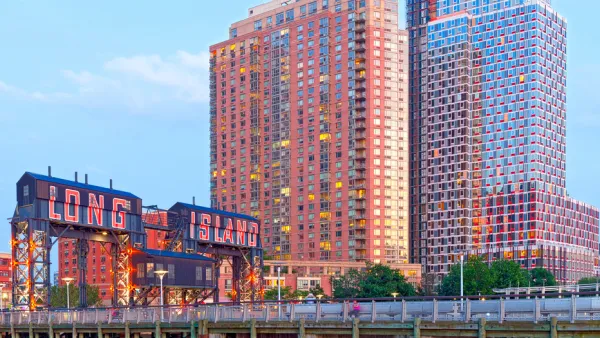New York City's population is expected to grow by one million residents by 2040. But where can housing be built to accommodate all these new residents? A new report from a Columbia University think tank identifies the most promising candidates.
Laura Kusisto looks at the findings of a new report [PDF] from Columbia University's Center for Urban Real Estate, which recommends the "most logical location for all this new housing: the city's waterfront neighborhoods, including Long Island City and Willets Point in Queens, Red Hook in Brooklyn and the Financial District..."
These recommendations, which "would pack more people into smaller areas than the Bloomberg administration has planned," raise some key questions about improvements that will need to be made to the city's existing infrastructure to accomodate such growth and address the city's growing inequity.
"Whether residents want more apartments in their neighborhoods remains to be seen," notes Kusisto. "In places such as Williamsburg where Bloomberg administration rezonings brought new residents, the result has been subway cars so packed that commuters wait for several trains to pass, lengthy kindergarten wait lists and promised parks that have yet to be delivered. The city has also yet to master the art of making tightly packed blocks of new glass towers feel like neighborhoods, rather than sterile enclaves."
Furthermore, focusing development along the waterfront, "raises serious questions after superstorm Sandy, when residents in Lower Manhattan, Long Island City and Red Hook were out of their homes for weeks or months."
FULL STORY: City's Boom Spurs a Need for Housing

Analysis: Cybertruck Fatality Rate Far Exceeds That of Ford Pinto
The Tesla Cybertruck was recalled seven times last year.

National Parks Layoffs Will Cause Communities to Lose Billions
Thousands of essential park workers were laid off this week, just before the busy spring break season.

Retro-silient?: America’s First “Eco-burb,” The Woodlands Turns 50
A master-planned community north of Houston offers lessons on green infrastructure and resilient design, but falls short of its founder’s lofty affordability and walkability goals.

Test News Post 1
This is a summary

Analysis: Cybertruck Fatality Rate Far Exceeds That of Ford Pinto
The Tesla Cybertruck was recalled seven times last year.

Test News Headline 46
Test for the image on the front page.
Urban Design for Planners 1: Software Tools
This six-course series explores essential urban design concepts using open source software and equips planners with the tools they need to participate fully in the urban design process.
Planning for Universal Design
Learn the tools for implementing Universal Design in planning regulations.
EMC Planning Group, Inc.
Planetizen
Planetizen
Mpact (formerly Rail~Volution)
Great Falls Development Authority, Inc.
HUDs Office of Policy Development and Research
NYU Wagner Graduate School of Public Service




























